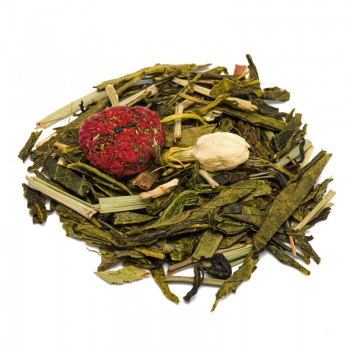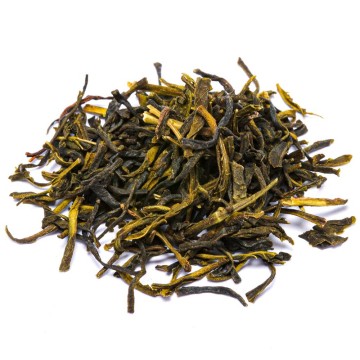This infusion with a sweet and aromatic blend gives an exquisite green tea. Each sip is delicate, smooth and full of aroma. Sencha green tea is balanced by floral and fruity notes, with rosebuds and blueberry, as well as raspberry inserts. The delicious interpretation of wellness teas, a blend with a unique and relaxing taste; precious but also beneficial with its properties - given by the red fruits and the virtues of the buds.
Properties and benefits of Blueberry green tea and rosebuds
The buds of naturally dried roses retain the well-being benefits of this flower. They are rich in vitamin C, an excellent antioxidant for the immune system and for keeping the skin glowing. Furthermore, from a nutritional point of view, rose buds contain vitamins A and E, minerals such as iron and potassium and some antioxidant polyphenols. Their action is recognized as beneficial in the response to stress, as an astringent to tone the tissues, as a contrast to irritation.
The antioxidants of rose buds join those of green tea and blueberry, for an action that helps counteract the harmful action of free radicals - which cause inflammation and oxidative stress, linked to ageing. Additionally, this tea contains gallic acid and anthocyanins, which may offer support for urinary tract health and vision.
For the urinary tract, the benefits of rosebud and blueberry help to eliminate waste from the bladder and kidneys with diuresis, with an action that maintains the well-being of the urinary tract. Drinking green tea with roses and blueberry can also promote the well-being of the digestive tract, in expelling substances that can accumulate in the intestine.
Essential oils and rose bud extracts contain higher amounts of antioxidants than petals infused in hot water alone, and for this reason they are selected in the blend. The red fruits, cranberries and raspberries, have been included for their qualities of stimulating diuresis, and the content of anthocyanin antioxidants and vitamin C. The purifying properties combine with those that promote microcirculation, useful for the circulatory system.< /p>
Origins and History of cultivation
The tea plant, native to areas of East Asia, India and Southeast Asia, is today cultivated in many tropical and subtropical regions of the planet. The tea drink, made from the leaves, was already consumed in China in 2700 BC, according to legend by Emperor Shennong and the elites of Chinese society. Over time it spread, and in the fourteenth century it became accessible to all, also appreciated for its medicinal qualities. Sencha is a particular type of green tea that is very popular in Japan, which developed its technique from the insights of a farmer, Nagatani Soen, at the beginning of the eighteenth century. His tea was prepared in a simple way, compared to pulverizing the leaves.
he decided to vaporize them and roll them into needles, thus blocking oxidation and maintaining their flavour. This Japanese green tea has been prepared with different methods over time, and today we have a wide selection of Sencha green tea. The rose, a plant and flower known since ancient times, has been harvested and then cultivated for millennia. Originally from Asia, the rose was also widespread among the ancient Egyptians, and we know that Cleopatra flooded her home with petals to seduce and fascinate.
It has an ancient association with love and romance. However, the herbal aspect of petals and buds was not overlooked. In ancient times, rosebud tea was considered an aphrodisiac, as well as a natural anti-inflammatory. In oriental medicine, Chinese rosebuds were considered to help regulate blood pressure, purify the skin, and bring harmony to the liver, spleen, and stomach. The cranberry was born as a fruit of the forest from both European and American plants.
Both the American cranberry and the European-Eurasian cranberry have been harvested for millennia for their tart sweetness and beneficial properties. Cranberries are harvested by hand in autumn, and in ancient times they entered the typical marshy environments where they grew in Europe, in order to recover the fruits when they turn completely red. In the Native American area, however, they used cranberries for recipes such as pemmican, combining them with meat and other fats. In addition, it was used in folk medicine to treat urinary and wound infections, oral hygiene, abdominal swelling.
Plant and flowers
Camellia sinensis, the tea plant, is an evergreen species belonging to the Theaceae family. The different varieties of the infusion are obtained from the leaves, including Sencha green tea. The difference is given by the processing, with various levels of oxidation. The shrub can grow very tall but is usually cut to less than 2 meters to facilitate hand-picking of the leaves, which takes place several times a year. Camellia sinensis develops better in the cool and humid tropical plateaus, and in deciduous forests, on sandy and clayey but well drained soils. The leaves show different shapes according to the variety.
The flowers are white and fragrant. The cranberry was born as the fruit of three different plant species, all attributable to the genus Vaccinium. The American cranberry plant can derive from small evergreen shrubs of the Oxycoccus subgenus: Vaccinium microcarpum (Oxycoccus microcarpus). Vaccinium oxycoccos (Oxycoccus palustris) grows in North America and Chile, in northern Europe and in northern Asia. However, cranberries can reach a height of about 60 centimeters and a length of up to 1.5 meters.
The flowers are dark pink, and the cranberry berry is larger than the leaves of the plant. It is born with a light green color, and tends to red in maturation. The Rose (genus Rosa) is a plant of the Rosaceae family, native to Asia and the temperate regions of the northern hemisphere. Cultivated for millennia, today it displays thousands of cultivars sought after for their flowers, of many shapes and colours.
Roses hybridize easily, creating the many types of garden roses we grow today. The plant can appear as an erect, climbing shrub, usually thorny. The flowers of the rose change in size and color from white to yellow and red to brown. The delicious scent of roses can vary depending on the variety and climatic conditions.
Nutritional values of Blueberry green tea and rosebuds
The components of this green tea are antioxidants and substances such as the amino acids theanine and arginine. Sencha tea makes ascorbic acid (vitamin C), vitamin B, caffeic and chlorogenic acid available. Contains catechin polyphenols (epigallocatechin-3-gallate EGCG, epigallocatechin EGC, epicatechin EC) and mineral salts (calcium, copper, iron, magnesium, phosphorus, potassium). It also contains methylxanthines such as caffeine, theobromine, theophylline.
Cranberries provide malic and citric acid, considered important for their purifying properties, good quantities of antioxidant anthocyanins and proanthocyanidins, vitamins A and C. Furthermore, it contains beneficial elements such as beta-carotene, lutein and zeaxanthin. Rosebuds have a composition with phytonutrients with antioxidant activity vitamin C, alkaloids, flavonoids, saponins, phenols, tannins, steroids and terpenoids. Additionally, nutrients include calcium and iron.
How to prepare cranberry and rosebud green tea
The infusion is obtained by placing in a cup (250 ml), about 3-5 grams of the blend of green tea with rosebuds and blueberry. Water at a temperature of 80 °C. Leave to infuse for 2 to 3 minutes, before drinking the Sencha tea infusion.
Blueberry green tea and rosebuds: side effects and contraindications
Rosebud cranberry tea is safe to consume in moderate amounts. However, there are side effects of Sencha and other green teas to be aware of, if the drink is taken in excessive doses. The tea contains tannins, compounds which, in excess, can cause an increase in stomach acids, causing symptoms such as nausea, heartburn and stomach pain.
Sencha also contains caffeine (theine) and people sensitive to this compound should avoid green tea before going to sleep. If caffeine is taken in excess, undesirable effects such as agitation, insomnia, palpitations, headache may occur. The possible side effect, in regards to the rose, is an allergic reaction for those who are allergic to the rose or rosehip plant. Cranberries in excessive quantities can act as natural laxatives, creating conditions for diarrhea, gastrointestinal irritation, gas and bloating.









 No reward points for this product.
No reward points for this product.


![Ginseng and ginger green tea [Natura d'Oriente]](https://www.naturadoriente.com/3367-home_default/Green-tea-ginseng-ginger.jpg)



![Green Tea Sencha Kombucha [Natura d'Oriente]](https://www.naturadoriente.com/3380-home_default/-green-tea-sencha-kombucha-.jpg)







![Green Tea Choui Fong Tea [Natura d'Oriente]](https://www.naturadoriente.com/3379-home_default/green-tea-choui-fong-tea.jpg)
![green tea roasted almond [Natura d'Oriente]](https://www.naturadoriente.com/3366-home_default/green-tea-with-roasted-almonds.jpg)